สวัสดีครับทุกคน ผมคือ Michael Zhang นักเดินทางชาวจีนที่มีประสบการณ์ท่องเที่ยวระดับนานาชาติอย่างกว้างขวาง ชื่นชอบการแบ่งปันเรื่องราวเกี่ยวกับประวัติศาสตร์ วัฒนธรรม และการท่องเที่ยวเชิงลึก ในทุกการเดินทางของผม ผมมักจะหลงใหลในเรื่องราวและวัฒนธรรมอันเป็นเอกลักษณ์ และวัดหลิงอิ่น (Lingyin Temple) ก็คือหนึ่งในสถานที่ที่เต็มไปด้วยมนต์เสน่ห์แบบนั้น วันนี้ผมจะพาคุณไปรู้จักกับวัดเก่าแก่ที่มีประวัติยาวนานกว่าพันปี สำรวจรากฐานทางวัฒนธรรมอันลึกซึ้ง รวมถึงไฮไลท์ที่ไม่ควรพลาด
สารบัญบทความ
- แนะนำวัดหลิงอิ่น
- แผนที่วัดหลิงอิ่น
- ทำไมต้องไปวัดหลิงอิ่นสักครั้งในชีวิต?
- สิ่งที่ต้องทำเมื่อมาเที่ยววัดหลิงอิ่น
- อาหารแนะนำใกล้วัดหลิงอิ่น
- วิธีเดินทางจากทะเลสาบซีหู (West Lake) ไปวัดหลิงอิ่น
- วิธีเดินทางจากตัวเมืองหางโจวไปวัดหลิงอิ่น
- วิธีเดินทางจากสนามบินหางโจวเสี้ยวซาน (Hangzhou Xiaoshan Airport) ไปวัดหลิงอิ่น
- คำถามที่พบบ่อย
แนะนำวัดหลิงอิ่น
วัดหลิงอิ่น (Lingyin Temple) หรือที่รู้จักอีกชื่อว่า วัดหยุนหลิน (Yunlin Temple) เป็นวัดพุทธเก่าแก่ของจีน ตั้งอยู่ที่เมืองหางโจว มณฑลเจ้อเจียง โดยมีภูเขาเป่ยเกาฟงอยู่ด้านหลัง และหันหน้าไปยังเขาเฟยไหล (Feilai Peak) วัดโบราณแห่งนี้ก่อตั้งขึ้นในสมัยราชวงศ์จิ้นตะวันออก เมื่อปี ค.ศ. 326 กินพื้นที่กว่า 87,000 ตารางเมตร ผู้ก่อตั้งวัดคือพระภิกษุฮุ่ยลี่จากอินเดียตะวันตก ต่อมาในสมัยราชวงศ์ซ่ง วัดหลิงอิ่นได้รับการยกย่องให้เป็นหนึ่งใน “ห้าวัดใหญ่แห่งเซนในแถบเจียงหนาน”
- ที่อยู่: เลขที่ 1 ถนนหลิงอิ่น ฝาหยุนซง เขตซีหู เมืองหางโจว มณฑลเจ้อเจียง
- เวลาเปิด:
- ฤดูหนาว: 06:30-17:45 (เริ่มปิดทำความสะอาดเวลา 17:30 ตั้งแต่กลางตุลาคมถึงกลางเมษายน)
- ฤดูร้อน: 06:30-18:15 (เริ่มปิดทำความสะอาดเวลา 18:00 ตั้งแต่กลางเมษายนถึงกลางตุลาคม)
- เวลาเที่ยวที่แนะนำ: 2-3 ชั่วโมง
- ฤดูที่เหมาะสม: เที่ยวได้ตลอดทั้งปี
- ค่าเข้าชม: ผู้ที่ไปวัดหลิงอิ่นจำเป็นต้องซื้อตั๋ว 2 ใบ
- ตั๋วเข้าเขตเฟยไหลเฟิง: 45 หยวน
- ตั๋วเข้าวัด (คูปองธูป): 30 หยวน
วัดหลิงอิ่นมีวันเปิดให้เข้าฟรี 12 วันต่อปี โดยไม่เก็บค่าคูปองธูป แต่ยังต้องซื้อตั๋วเข้าเขตเฟยไหลเฟิง
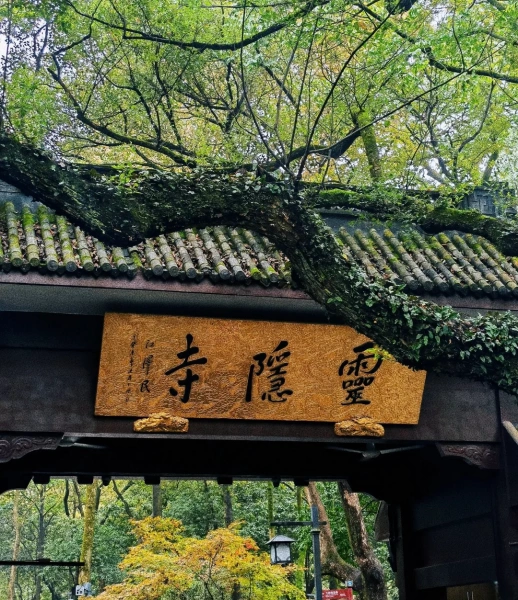
แผนที่วัดหลิงอิ่น
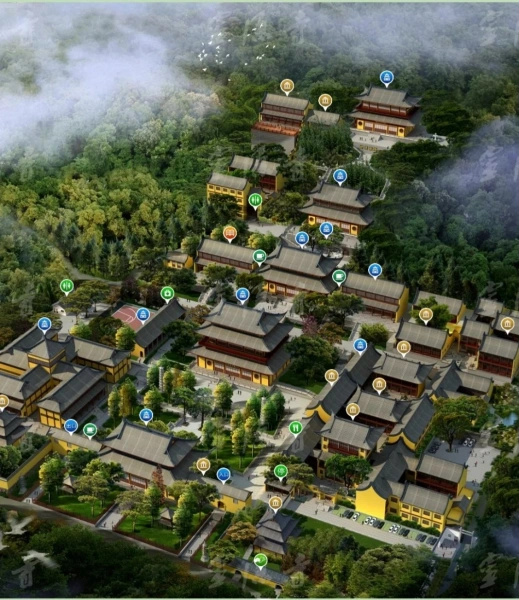
ทำไมต้องไปวัดหลิงอิ่นสักครั้งในชีวิต?
ประวัติศาสตร์อันยาวนาน
วัดหลิงอิ่นก่อตั้งขึ้นตั้งแต่ปี ค.ศ. 326 จนถึงวันนี้มีอายุกว่า 1,700 ปี ถือเป็นหนึ่งในวัดที่เก่าแก่ที่สุดของจีน วัดตั้งอยู่เชิงเขาเฟยไหลใกล้ทะเลสาบซีหู ด้านหลังพิงภูเขาเป่ยเกาฟง ด้านหน้าเผชิญกับเขาเฟยไหล ล้อมรอบด้วยป่าเขาเขียวชอุ่ม ทำให้บรรยากาศกลมกลืนกับธรรมชาติ จนได้รับการขนานนามว่า “สวรรค์บนดิน” วัดหลิงอิ่นยังเป็นหนึ่งในต้นกำเนิดสำคัญของพุทธนิกายเซน และมีพระเกจิผู้มีชื่อเสียงมากมาย ภายในวัดมีพระอุโบสถ พระพุทธรูป จิตรกรรมฝาผนัง และเจดีย์หินที่ล้วนมีคุณค่าทางประวัติศาสตร์และวัฒนธรรมสูงมาก
วัฒนธรรมที่ลึกซึ้ง
วัดหลิงอิ่นไม่ใช่เพียงแค่วัดพุทธเก่าแก่ แต่ยังเป็นศูนย์กลางการแลกเปลี่ยนวัฒนธรรมที่สำคัญ ทุกๆ ฤดูใบไม้ผลิ จะมีการจัดงานเทศกาลวันประสูติพระพุทธเจ้า ภายในงานมีทั้งพิธีกรรมทางศาสนาและการแสดงประเพณีดั้งเดิม ดึงดูดทั้งผู้ศรัทธาและนักท่องเที่ยวจำนวนมาก นอกจากนี้วัดยังเก็บรักษาพระพุทธรูปเก่า เครื่องสักการะ เสาหินจารึก เจดีย์ พระราชโองการหิน และงานศิลป์ล้ำค่าอีกมากมาย สิ่งเหล่านี้สะท้อนให้เห็นถึงความสำคัญทางวัฒนธรรมพุทธของจีนอย่างแท้จริง
สิ่งที่ต้องทำเมื่อมาเที่ยววัดหลิงอิ่น
สถานที่สำคัญภายในวัด
วิหารเทพเจ้าสี่ทิศ (Tianwang Hall)
วิหารแห่งนี้คือประตูแรกของวัดหลิงอิ่น ภายในประดิษฐานพระศรีอารยเมตไตรยและเทพเจ้าสี่ทิศ ซึ่งเป็นสัญลักษณ์แห่งความสงบสุข ฝนฟ้าตกต้องตามฤดูกาล และบ้านเมืองร่มเย็นเป็นสุข นักท่องเที่ยวจำนวนมากนิยมมาสักการะเพื่อขอพรให้ครอบครัวมีความสงบและสามัคคี สถาปัตยกรรมของวิหารสง่างาม และเป็นจุดเริ่มต้นที่ดีในการสัมผัสพุทธศิลป์ของวัด
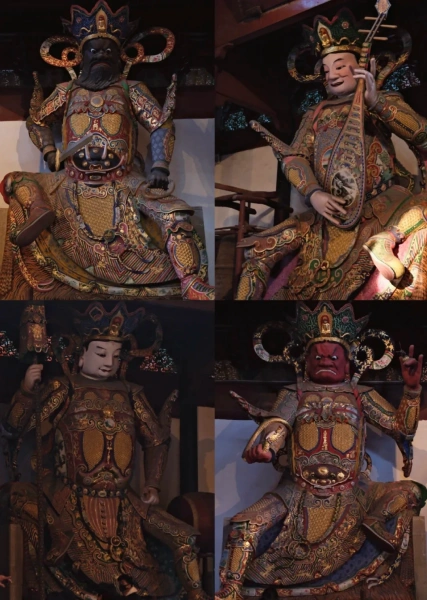
พระอุโบสถใหญ่ (Mahavira Hall)
พระอุโบสถใหญ่เป็นศูนย์กลางของวัดหลิงอิ่น ภายในประดิษฐานพระพุทธรูปศากยมุนี แทนสัญลักษณ์แห่งปัญญาและความเมตตา ไม่ว่าคุณจะเผชิญความสับสนในชีวิตหรือมีความหวังต่ออนาคต ที่นี่คือสถานที่สำหรับการภาวนาและแสวงหาความสงบภายในใจ นอกจากนี้ยังถือเป็นสถาปัตยกรรมที่โดดเด่นที่สุดของวัด
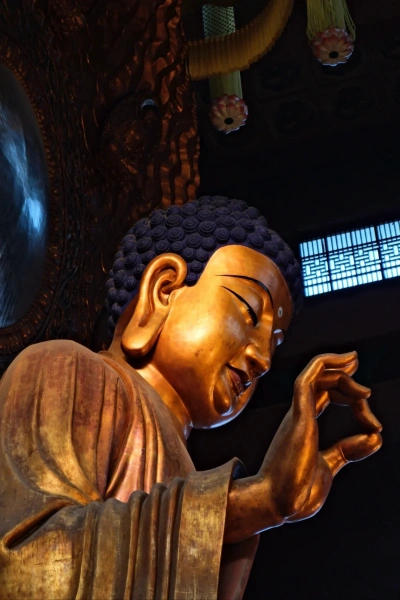
วิหารพระพุทธเจ้าผู้รักษาโรค (Medicine Buddha Hall)
ภายในวิหารประดิษฐานพระพุทธเจ้าพุทธไวฑูรย์ หรือที่รู้จักในนามพระพุทธเจ้าหมอ ซึ่งผู้คนเชื่อว่าเป็นผู้ปกปักรักษาสุขภาพและป้องกันภัยพิบัติ นักท่องเที่ยวมากมายตั้งใจมาที่นี่เพื่อขอพรให้ตนเองและครอบครัวแข็งแรง และหวังในความคุ้มครองจากพระพุทธเจ้าหมอเพื่อชีวิตที่ปลอดภัย
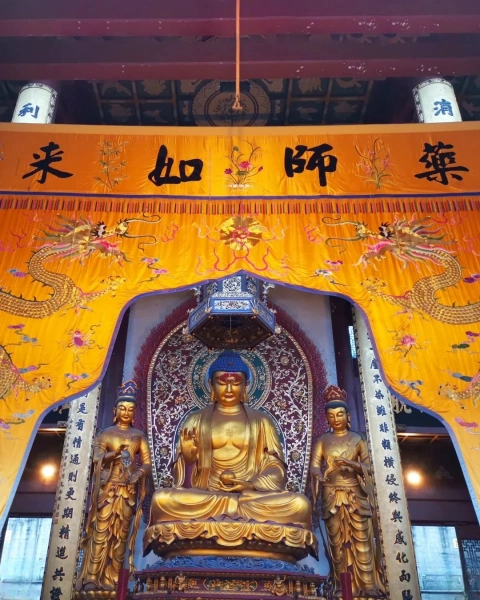
วิหารพระพุทธเจ้าสามองค์ (Huayan Hall)
ภายในประดิษฐานพระพุทธเจ้าสามองค์ ได้แก่ พระไวโรจนะ (ขอพรเรื่องปัดเป่าสิ่งไม่ดี) พระมันชุศรี (ขอพรเรื่องการเรียนและสติปัญญา) และพระสมันตภัทร (ขอพรเรื่องหน้าที่การงาน) ทำให้ทั้งนักเรียนและคนทำงานนิยมมาที่นี่เพื่อขอพร สัมผัสพลังแห่งพระธรรม และหวังในความสำเร็จในชีวิต
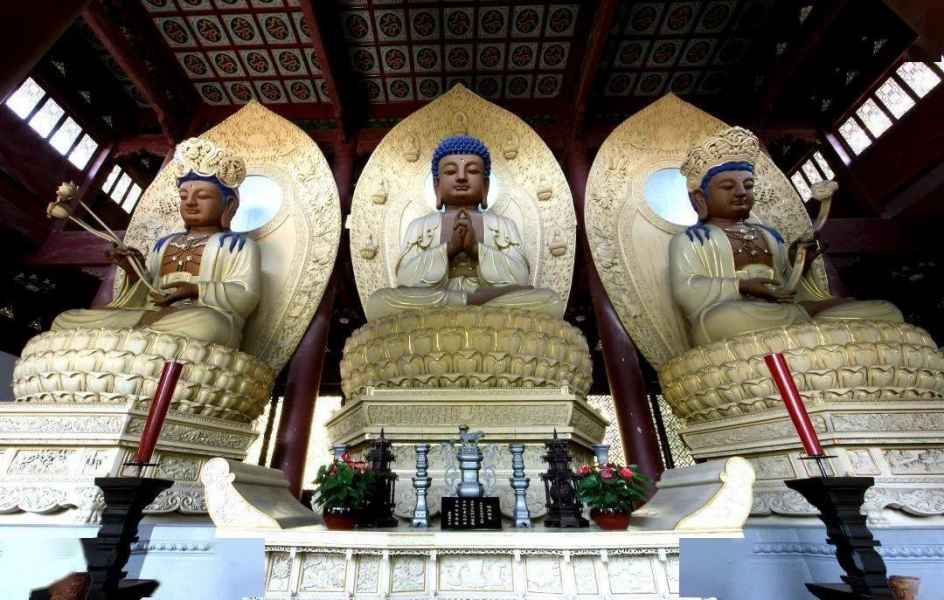
วิหารท่านจี๋กง (Ji Gong Hall)
ที่นี่ประดิษฐานพระจี๋กง ผู้เป็นที่รู้จักในด้านปัญญาและอารมณ์ขัน ท่านเป็นสัญลักษณ์แห่งโชคดีและความสุข นักท่องเที่ยวมักมาขอพรเพื่ออนาคตที่สดใส พร้อมทั้งสัมผัสถึงจิตวิญญาณแห่งความเมตตาของท่านจี๋กง ทำให้การเดินทางเต็มไปด้วยรอยยิ้มและความอบอุ่น
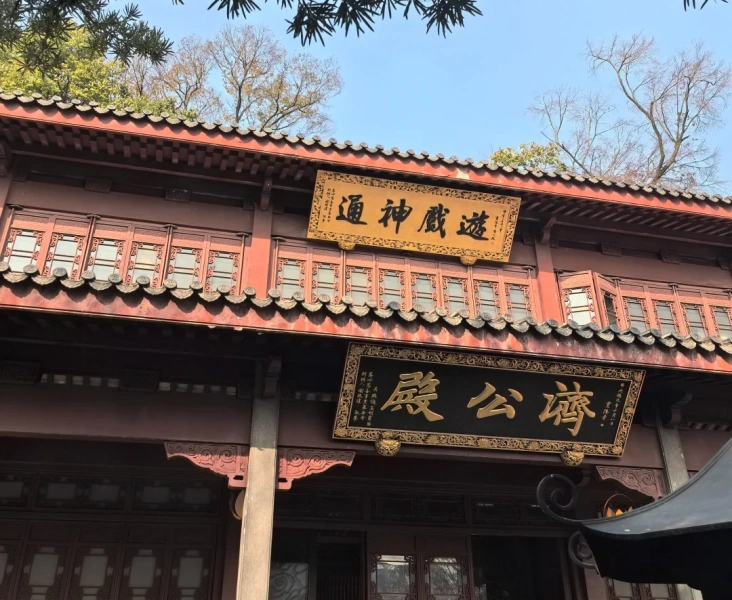
คู่มือบัตรเข้าชมวัดหลิงอิ่น
ราคาบัตรเข้าวัดหลิงอิ่น (คูปองธูป)
- ผู้ใหญ่: 30 หยวน
- เด็ก: 15 หยวน (อายุ 6-18 ปี)
- นักเรียน: 15 หยวน (ระดับปริญญาตรีหรือต่ำกว่า)
- ผู้สูงอายุ: 15 หยวน (อายุ 60-69 ปี)
- ฟรี: เด็กอายุต่ำกว่า 6 ปี และผู้สูงอายุ 70 ปีขึ้นไป
เวลาเปิด-ปิด
- ฤดูหนาว: 06:30-17:45 (เริ่มปิดทำความสะอาดเวลา 17:30 ช่วงประมาณกลางตุลาคมถึงกลางเมษายน)
- ฤดูร้อน: 06:30-18:15 (เริ่มปิดทำความสะอาดเวลา 18:00 ช่วงประมาณกลางเมษายนถึงกลางตุลาคม)
วันเข้าฟรีวัดหลิงอิ่น
วัดหลิงอิ่นมีวันเปิดให้เข้าชมฟรี 12 วันต่อปี โดยไม่เก็บค่าคูปองธูป แต่ยังต้องซื้อตั๋วเข้าเขตเฟยไหลเฟิง (Feilai Peak) รายการวันเข้าฟรีมีดังนี้:
- วันที่ 8 เดือน 12 ตามปฏิทินจันทรคติ: วันตรัสรู้ของพระพุทธเจ้า
- วันที่ 30 เดือน 12 (ช่วงเช้า): วันส่งท้ายปีเก่า
- วันที่ 19 เดือน 2: วันประสูติพระโพธิสัตว์กวนอิม
- วันที่ 26 เดือน 2: เทศกาลเช็งเม้ง
- วันที่ 8 เดือน 4: วันประสูติพระพุทธเจ้า
- วันที่ 19 เดือน 5: วันทะเลสาบซีหู เมืองหางโจว
- วันที่ 19 เดือน 6: วันตรัสรู้ของพระโพธิสัตว์กวนอิม
- วันที่ 15 เดือน 7: เทศกาลอุลลัมพะนะ (วันสารทจีน)
- วันที่ 15 เดือน 8: เทศกาลไหว้พระจันทร์
- วันที่ 19 เดือน 9: วันบวชของพระโพธิสัตว์กวนอิม
- วันที่ 13 เดือน 11: วันรำลึกสาธารณะแห่งชาติ
- วันที่ 21 เดือน 11: วันตงจื้อ (วันเหมายัน)
ช่องทางการซื้อตั๋ว
- ออฟไลน์: คูปองธูปสำหรับเข้าวัดสามารถซื้อได้ที่หน้าประตูวัดเท่านั้น ส่วนบัตรเข้าเขตเฟยไหลเฟิงสามารถซื้อได้หน้างาน
- ออนไลน์: มีบริการขายเฉพาะตั๋วเขตเฟยไหลเฟิง
คู่มือการไหว้พระและจุดธูปที่วัดหลิงอิ่น
วิธีการไหว้พระและจุดธูปที่วัดหลิงอิ่น
เมื่อเข้าสู่วัดหลิงอิ่น คุณจะได้รับธูปฟรี 3 ดอก (รวมอยู่ในค่าบัตรแล้ว) ไม่จำเป็นต้องซื้อจากร้านด้านนอก ขั้นตอนการไหว้และขอพรมีดังนี้:
- รับธูป: ที่ทางเข้าวัด เจ้าหน้าที่จะแจกธูปฟรี
- จุดธูป: ใช้ไฟจากเทียนที่ตั้งอยู่หน้าวิหารต่างๆ จุดธูปด้วยมือซ้าย หากไฟลุกแรงเกินไปให้ใช้มือโบกเบาๆ ห้ามเป่าด้วยปาก
- ถือธูป: มือซ้ายอยู่ด้านบน มือขวาด้านล่าง นิ้วโป้งทั้งสองข้างกดปลายธูปไว้ ยกธูปขึ้นระดับคิ้ว ปลายธูปชี้ไปที่พระพุทธรูป
- อธิษฐาน: กล่าวนามพระหรือสิ่งศักดิ์สิทธิ์ พร้อมบอกชื่อ-นามสกุลและภูมิลำเนาของตน ควรขอพรเพียงเรื่องเดียว เช่น ขอให้สุขภาพดี การงานก้าวหน้า หรือครอบครัวมีความสุข
- ไหว้สามครั้งและก้มกราบเก้าครั้ง: ยืนพนมมือไหว้สามครั้ง จากนั้นคุกเข่ากราบสามครั้ง ทำซ้ำสามรอบจึงถือว่าสำเร็จพิธี
- ปักธูป: นำธูปไปปักลงในกระถางธูปด้วยท่าทีสงบและเคารพ
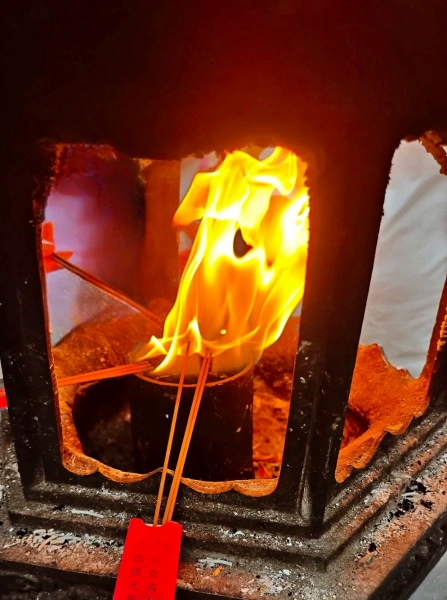
อาหารแนะนำใกล้วัดหลิงอิ่น
ร้านก๋วยเตี๋ยวเจใกล้วัดหลิงอิ่นถือเป็นประสบการณ์ที่ไม่ควรพลาด ร้านตั้งอยู่ด้านขวาของทางเข้าวัด หาเจอง่าย ราคาย่อมเยา เพียงชามละ 20 หยวน และยังคงเอกลักษณ์ของวัฒนธรรมอาหารเจแบบพุทธ เมนูมี 2 แบบคือ “บะหมี่ช่างเซิง” และ “บะหมี่ช่างโซ่ว” โดยเฉพาะบะหมี่ช่างเซิงที่ได้รับความนิยมมากเพราะหอมและรสชาติเข้มข้น หลังจากไหว้พระเสร็จ การได้กินก๋วยเตี๋ยวเจสักชามไม่เพียงเติมพลังงาน แต่ยังทำให้คุณได้สัมผัสถึงความเรียบง่ายและความบริสุทธิ์ในวิถีชีวิตแบบพุทธ เพิ่มสีสันให้กับการเดินทางของคุณ
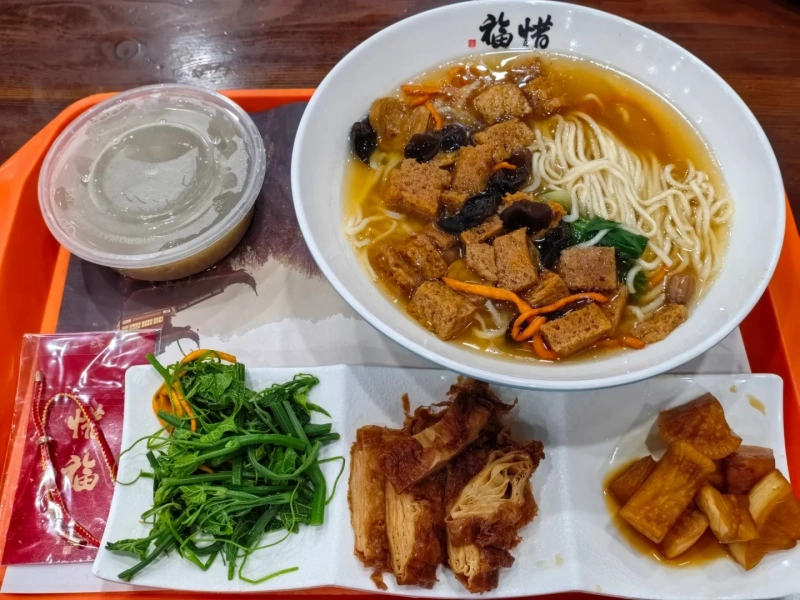
วิธีเดินทางจากทะเลสาบซีหู (West Lake) ไปวัดหลิงอิ่น
ระยะทางจากทะเลสาบซีหูไปวัดหลิงอิ่นค่อนข้างใกล้ และมีหลายวิธีเดินทางให้เลือก:
- เดินเท้า: จากเขื่อนซูตี (Su Causeway) ที่ทะเลสาบซีหู เดินไปวัดหลิงอิ่นใช้เวลาประมาณ 30 นาที ระหว่างทางร่มรื่นด้วยต้นไม้และทิวทัศน์สวยงาม เหมาะกับการเดินเล่นผ่อนคลาย
- รถประจำทาง: ขึ้นรถบัสสาย 7 หรือ 807 จากสถานีต้วนเฉียว (Duanqiao) หรือซูตี (Su Causeway) ลงที่ป้ายหลิงอิ่น จากนั้นเดินต่อเพียงไม่กี่นาทีก็ถึงวัด
- แท็กซี่/รถเรียกผ่านแอป: จากโซนหลักของทะเลสาบซีหู นั่งรถใช้เวลาประมาณ 10-15 นาที ค่าโดยสารอยู่ที่ประมาณ 20-25 หยวน
วิธีเดินทางจากตัวเมืองหางโจวไปวัดหลิงอิ่น
รถไฟฟ้าใต้ดิน (Metro)
จากตัวเมืองหางโจว ขึ้นรถไฟฟ้าใต้ดินสาย 2 ไปสถานีเฟิงฉีลู่ (Fengqi Road) จากนั้นต่อรถบัสสาย 7 หรือ 807 ลงที่ป้ายหลิงอิ่น ใช้เวลาทั้งหมดประมาณ 40 นาที เส้นทางนี้ประหยัดและสะดวก เหมาะกับนักท่องเที่ยวส่วนใหญ่
รถประจำทาง (Bus)
ในตัวเมืองหางโจวมีรถบัสหลายสายที่ไปถึงวัดหลิงอิ่นโดยตรง เช่น สาย 7, 807 และ 324 ลงที่ป้ายหลิงอิ่นแล้วเดินต่อไม่กี่นาทีถึงวัด การนั่งรถบัสเป็นวิธีที่ประหยัดค่าใช้จ่ายและเป็นมิตรต่อสิ่งแวดล้อม ใช้เวลาเดินทางประมาณ 40 นาที
แท็กซี่/รถเรียกผ่านแอป
จากใจกลางเมืองหางโจว (เช่น จัตุรัสอู่หลิน) นั่งแท็กซี่ไปวัดหลิงอิ่นใช้เวลาประมาณ 30 นาที ค่าโดยสารประมาณ 50 หยวน วิธีนี้สะดวกและรวดเร็ว เหมาะสำหรับนักท่องเที่ยวที่มีสัมภาระ
วิธีเดินทางจากสนามบินหางโจวเสี้ยวซาน (Hangzhou Xiaoshan Airport) ไปวัดหลิงอิ่น
รถไฟฟ้าใต้ดิน (Metro)
จากสนามบินหางโจวเสี้ยวซาน นั่งรถไฟฟ้าใต้ดินสาย 7 ไปสถานีเฉียนเจียงลู่ (Qianjiang Road) จากนั้นเปลี่ยนไปสาย 2 ถึงสถานีเฟิงฉีลู่ (Fengqi Road) ต่อด้วยรถบัสสาย 7 ไปลงที่ป้ายหลิงอิ่น ใช้เวลาทั้งหมดประมาณ 1 ชั่วโมง 30 นาที วิธีนี้ประหยัดที่สุด
รถบัสสนามบิน (Airport Shuttle Bus)
จากสนามบินนั่งรถบัสสนามบินไปยังสถานีอู่หลินเหมิน (Wulinmen) ใช้เวลาประมาณ 60 นาที จากนั้นต่อรถบัสสาย 7 หรือ 807 ไปลงที่วัดหลิงอิ่น รวมเวลาทั้งหมดประมาณ 1 ชั่วโมง 20 นาที
แท็กซี่/รถเรียกผ่านแอป
นั่งแท็กซี่หรือรถเรียกผ่านแอปจากสนามบินไปวัดหลิงอิ่น ใช้เวลาประมาณ 50 นาที ค่าโดยสารประมาณ 150 หยวน วิธีนี้สะดวกและรวดเร็วที่สุด เหมาะสำหรับผู้ที่ต้องการความสบาย
คำถามที่พบบ่อย
พื้นที่ส่วนใหญ่ของวัดหลิงอิ่นเป็นทางเดินหินที่ราบเรียบ เหมาะสำหรับการใช้รถเข็นเด็กและวีลแชร์ อย่างไรก็ตาม บางวิหารและจุดชมวิวมีบันได ซึ่งอาจเป็นอุปสรรคได้ แนะนำให้นำรถเข็นแบบเบา หรือให้ครอบครัวช่วยเหลือ วัดมีการออกแบบพื้นที่เปิดและเส้นทางไหว้พระที่ค่อนข้างสะดวก ทำให้สามารถใช้รถเข็นได้ในหลายจุด
ลานจอดรถของวัดหลิงอิ่นมีบริการฝากกระเป๋าแบบเสียค่าใช้จ่าย ราคาประมาณ 20 หยวนต่อชิ้น นอกจากนี้ ร้านค้าข้างๆ ทางเข้า ก็มีบริการฝากของในราคาใกล้เคียงกัน แต่ต้องมารับของคืนก่อนเวลา 17:30 บริการเหล่านี้เหมาะสำหรับนักท่องเที่ยวที่มีกระเป๋าเดินทางขนาดใหญ่ ทำให้สะดวกสบายมากขึ้น
รวมลิงก์แนะนำเที่ยวหางโจวที่จำเป็น
- คู่มือเที่ยวหางโจวฉบับสมบูรณ์ 📖
- แนะนำที่พัก 🏨
- คู่มือการเดินทาง ✈️ 🚇 🚄 🚆
- เคล็ดลับและข้อมูลจำเป็นในการท่องเที่ยว 🗺️ 🍜 📱 💸 🌤️ 💊
- 🗺️ แผนที่หางโจว
- 🍜 แนะนำอาหารอร่อยในหางโจว
- 📱 แอปพลิเคชันจำเป็นสำหรับการท่องเที่ยว
- 💸 คู่มือขอคืนภาษี (Tax Refund) ในจีน
- 🌤️ ข้อมูลสภาพอากาศหางโจว
- 💊 รายการยาจำเป็นที่ควรนำไปเที่ยวจีน
- 🛍️ ดีลท่องเที่ยวในประเทศจีน
- 🔌 ปลั๊กจีน แรงดันไฟฟ้า และคู่มือปลั๊กไฟจีน
- 📶 วิธีการใช้ eSIM ในประเทศจีน
- 🧳 รายการบรรจุภัณฑ์และเช็คลิสต์การเดินทาง

 English (US)
English (US)  繁體中文
繁體中文 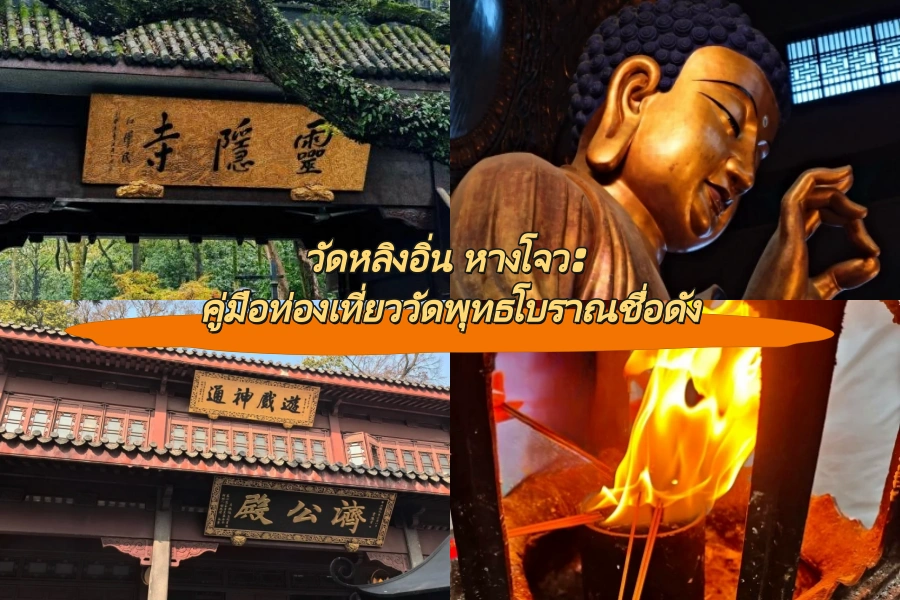
Comment (0)